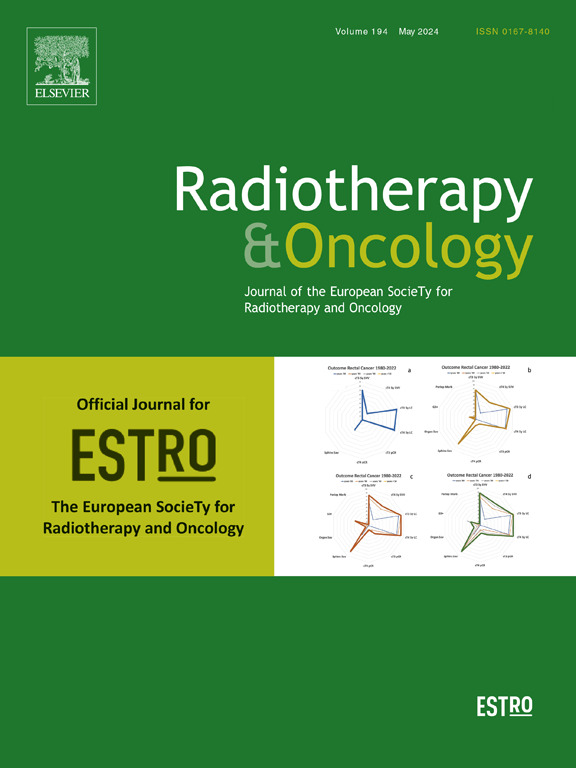Control of dental calculus Prevents severe Radiation-Induced oral mucositis in patients undergoing radiotherapy for nasopharyngeal carcinoma
IF 4.9
1区 医学
Q1 ONCOLOGY
引用次数: 0
Abstract
Purpose
This study aims to develop an artificial intelligence model to predict severe radiation-induced oral mucositis (RIOM) in patients with locally advanced nasopharyngeal carcinoma (LA-NPC) and verify the risk factors associated with severe RIOM.
Methods and Materials
A total of 578 patients diagnosed with LA-NPC and undergoing radiotherapy were enrolled in this study. This cohort comprised 430 retrospective patients used for model development/validation, and 148 patients for the prospective verification study. Multifaceted data related to RIOM were collected to build an explainable multi-classifier fusion (MCF) model to identify severe RIOM associated risk factors. A prospective study was designed to validate the key risk factors.
Results
The MCF model demonstrated satisfactory performance in severe RIOM prediction when integrating all dosimetric, clinical, and oral features, with an AUC of 0.904, ACC of 0.849, SEN of 0.853 and SPE of 0.846 on the independent testing set. The dental calculus index of 2 was identified as a significant key risk factor for developing RIOM. The severe RIOM rate in the prospective intervention cohort was 8.1 % (95 % CI:4.3 %∼13.7 %), lower than that in the model development cohort, with a decrease of 31 % (95 % CI23.9 %∼36.8 %, p < 0.0001).
Conclusions
The developed model can serve as a valuable tool for providing timely alerts for high-risk patients with the severe RIOM and assisting physicians in optimizing treatment management. The dental calculus index is a key independent risk factor for severe RIOM. The effective control of the dental calculus can significantly mitigate the onset of severe RIOM.
ClinicalTrials.gov: NCT05858385.
控制牙石可预防鼻咽癌放射治疗患者发生严重的放射性口腔黏膜炎。
目的:建立局部晚期鼻咽癌(LA-NPC)患者重度放射性口腔黏膜炎(RIOM)的人工智能预测模型,并验证严重RIOM的相关危险因素。方法与材料:本研究共纳入578例确诊为LA-NPC并接受放疗的患者。该队列包括430例用于模型开发/验证的回顾性患者,以及148例用于前瞻性验证研究的患者。收集与RIOM相关的多方面数据,建立可解释的多分类器融合(MCF)模型,以识别严重的RIOM相关危险因素。一项前瞻性研究旨在验证关键危险因素。结果:综合所有剂量学、临床和口腔特征,MCF模型在预测严重RIOM方面表现出令人满意的性能,在独立测试集中AUC为0.904,ACC为0.849,SEN为0.853,SPE为0.846。牙结石指数为2是发生RIOM的重要关键危险因素。前瞻性干预组的严重RIOM率是8.1 %(95 % CI: 4.3 % 13.7∼ %),低于模型开发队列,以减少31 %(95 % CI23.9 % 36.8∼ %,p 结论:开发模型可以作为一个有价值的工具,用于对高危患者严重RIOM提供及时的提醒和协助医生在优化治疗管理。牙结石指数是严重RIOM的重要独立危险因素。有效控制牙结石可显著减轻严重RIOM的发生。Clinicaltrials: gov: NCT05858385。
本文章由计算机程序翻译,如有差异,请以英文原文为准。
求助全文
约1分钟内获得全文
求助全文
来源期刊

Radiotherapy and Oncology
医学-核医学
CiteScore
10.30
自引率
10.50%
发文量
2445
审稿时长
45 days
期刊介绍:
Radiotherapy and Oncology publishes papers describing original research as well as review articles. It covers areas of interest relating to radiation oncology. This includes: clinical radiotherapy, combined modality treatment, translational studies, epidemiological outcomes, imaging, dosimetry, and radiation therapy planning, experimental work in radiobiology, chemobiology, hyperthermia and tumour biology, as well as data science in radiation oncology and physics aspects relevant to oncology.Papers on more general aspects of interest to the radiation oncologist including chemotherapy, surgery and immunology are also published.
 求助内容:
求助内容: 应助结果提醒方式:
应助结果提醒方式:


